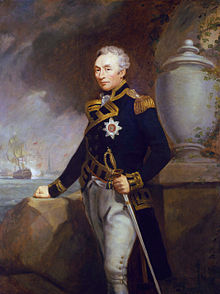Thomas Graves (admiral)
| Sir Thomas Graves | |
|---|---|

Thomas Graves in rear-admiral's full-dress uniform (Oil, by James Northcote, collections of the National Maritime Museum)
|
|
| Born | c.1747 |
| Died | March 29, 1814 (aged 66–67) Woodbine Hill, Honiton, Devon |
| Allegiance |
|
| Service/branch |
|
| Years of service | – 1814 |
| Rank | Admiral |
| Commands held |
HMS Diana HMS Savage HMS Bedford HMS Magicienne HMS Cumberland |
| Battles/wars | |
| Awards | Knight Commander of the Bath |
Sir Thomas Graves KB (c.1747 – 29 March 1814) was an officer of the Royal Navy who rose to the rank of admiral after service in the Seven Years' War, the American War of Independence, and the French Revolutionary and Napoleonic Wars.
Thomas Graves was born circa 1747, the third son of Reverend John Graves of Castle Dawson, County Londonderry, by his wife Jane Hudson. He was a nephew of Admiral Samuel Graves and a first cousin once removed of Admiral Thomas, Lord Graves. Graves' three brothers all served as captains in the navy, becoming admirals on the superannuated list. Thomas entered the navy at a very early age, and served during the Seven Years' War with his uncle Samuel on board HMS Scorpion, Duke, and Venus. After the peace he was appointed to HMS Antelope with his cousin Thomas, whom he followed to the HMS Edgar, and by whom, in 1765, while on the coast of Africa, he was promoted to be lieutenant of HMS Shannon. It is stated in Foster's ‘Peerage’ that he was born in 1752, a date incompatible with the facts of his known service: by the Regulations of the Navy he was bound to be twenty years old at the date of his promotion, and though the order was often grossly infringed, it is highly improbable that he was only thirteen: it may fairly be assumed that he was at least eighteen in 1765.
In 1770 Graves was lieutenant of HMS Arethusa, and in 1773 was appointed to HMS Racehorse with Captain Constantine Phipps for the voyage of discovery in the Arctic Seas. In the following year he went out to North America with his uncle Samuel, and was appointed by him to command HMS Diana, one of the small schooners employed for the prevention of smuggling. She had thirty men, with an armament of four 2-pounders, and on 27 May 1775, being sent from Boston into the Charles River, was attacked by a large force of insurgents, whose numbers swelled till they reached a total of something like two thousand men, with two field-pieces. It fell calm, and towards midnight, as the tide ebbed, Diana ran aground, and lay over on her side, when the colonial forces succeeded in setting her on fire, and the small crew, after a gallant defence, were compelled to abandon her, Graves having been first severely burnt, as well as his brother John, then a lieutenant of the flagship HMS Preston, who had been sent in one of the Preston's boats to the Diana's support.
...
Wikipedia
